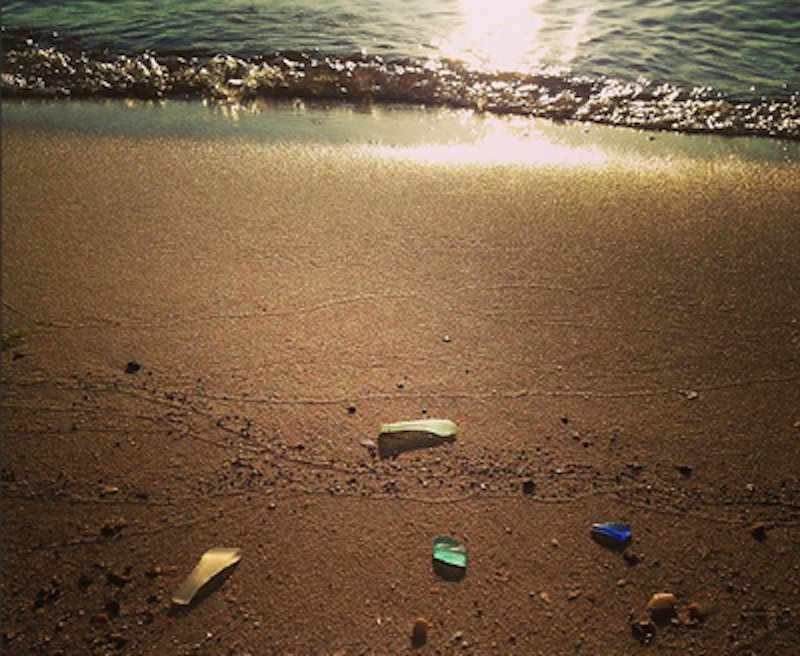No, this isn’t satire. I really am a sea glass hunter for my hobby. There are sea glass hunters all over the world. I know, because we all use the #seaglass hashtag on Instagram and watch each other’s pictures of our finds each day. I actually opened a shop on Etsy because I was scared I was crossing over into the “sea glass hoarder” zone.
Since I have a decade and a half of sea glass hunting experience, I would like to offer the following tips, tricks and advice for wannabe sea glass hunters.
- Be close to a coastline. Although you can (and I encourage you to) buy sea glass online, that’s not really sea glass hunting and certainly isn’t the same as finding it yourself. The ocean isn’t always the best place to find sea glass unless you are in a really cool remote part of Massachusetts, Maine, Newfoundland, England or Alaska. Non-ocean bodies of water, for example the Great Lakes, as well as bays, lakes and rivers, can also be great sources for finds. If you’re traveling, Google “sea glass” and the place you’re going, and sometimes an article from a sea glass journal will come up that tells you where to look.
- Know Your History. The glass has to come from somewhere. It doesn’t randomly show up on the beach. Perhaps there was an old amusement pier, hotel or other waterfront recreational area nearby. These are great potential sea glass beach spots. And if you can find a map of old shipwrecks that were close to the coastline? Even better. Sometimes, glass is actually eroding from land, so if you know where (very) old trash dumpsites (often directly into the water) were in the area, that’s a good place to hunt.
- Go at low tide. Sea glass hunting is all about the tide charts. Get the free app on your phone; I schedule my entire day around mine. The tides are only one factor, though. Sea glass abundance is also affected by the direction of the wind, the season of the year (winter is best) and especially, the moon (full moons mean lower tides).
- Be picky. If you can see through a piece of glass, it’s broken glass, not sea glass, and there is a difference. Throw it back in the water and let it tumble around longer. Drives me nuts when people post pictures of “sea glass” that’s actually shards of broken 90s Michelob or Heineken bottles. Seriously? Broken glass is not sea glass.
- Be careful out there. I know, this sounds silly, I mean, you’re walking on a beach, right? Not necessarily. You can also be absentmindedly wandering into the water. I’ve had close encounters with snakes, a jellyfish sting in the privates and a cut from a broken bottle piece that sent me to the ER. I actually almost tripped over a dead dolphin on the beach a few weeks ago. Sea glass sunburn (back of neck) hurts like hell, and so will your lower back from bending over 1000 times. I even got thrown off a firing range by the U.S. Coast Guard. Oopsy. So pay attention to your surroundings, which seems simple, but is hard when you’re focused on searching for the next cool piece.
- Read The Bible. The best book there is on sea glass hunting is Pure Sea Glass by Richard Lamotte. I call him Sea Glass Jesus. He founded an organization called the North American Sea Glass Association, whose conference (I've thought about skipping my sister's wedding to attend) is in Virginia Beach this year. I am fortunate enough to live near Lamotte, so I have stalked his lectures, gotten him to date some of my pieces, interviewed him for articles and generally stalker-worshipped him. He can tell you what a piece of sea glass used to be and date it to within ten years. He’s amazing. Read his book to learn about identification, history, hunting tips, rarity of colors, and anything else you might need to know about sea glass.
- Take Your Time. Don’t even go to a sea glass beach if you have less than an hour. If you’re in a rush, you’ll miss all the best pieces. You have to take your time and scan the beach like you’re reading a book. You have to walk the beach first at the low tide line, then turn around and walk the high tide line on the beach on your way back. There’s comfort in the ritual of sea glass hunting, even the sorting of it afterwards.
My final piece of advice would be not to ask sea glass hunters where they hunt. You think we’re going to tell you where the beach is that we find all our good shit on? No. Find one yourself. It’s like Fight Club: the first rule of sea glass hunting is that we don’t talk about sea glass hunting spots.
Read more sea glass articles by Mary McCarthy (@marymac).

